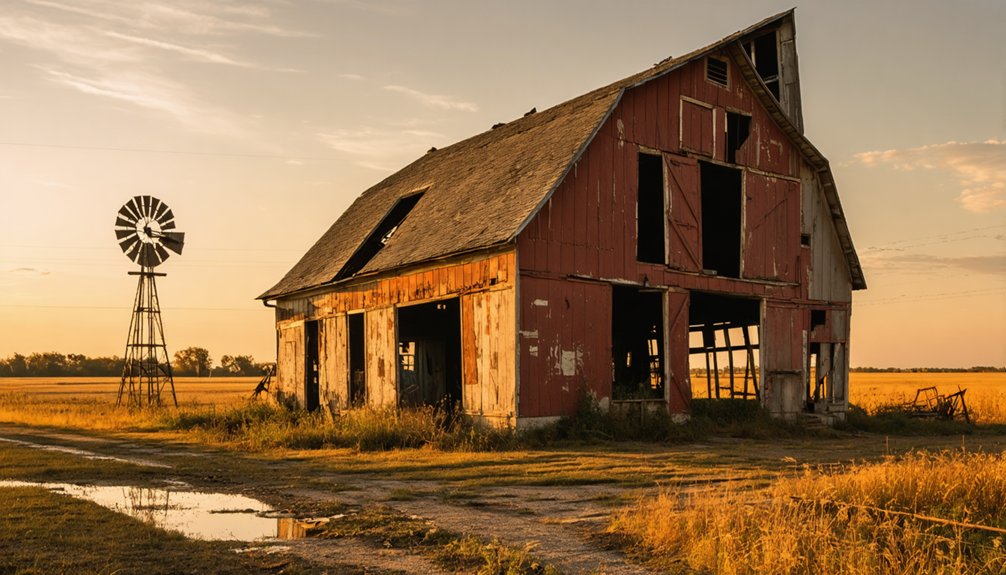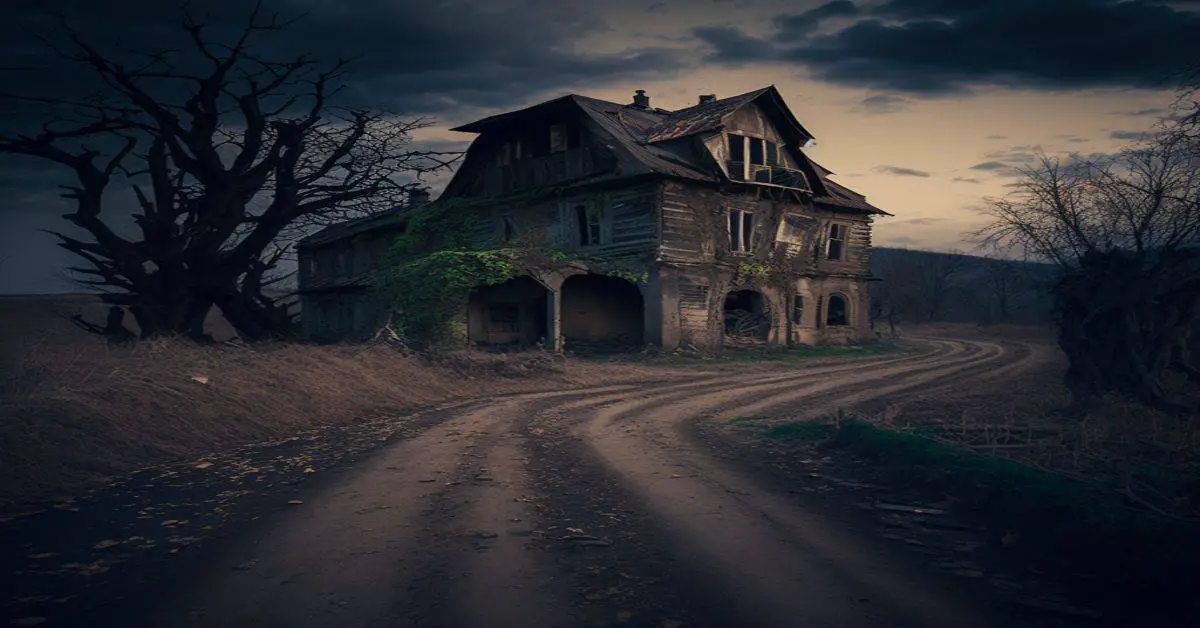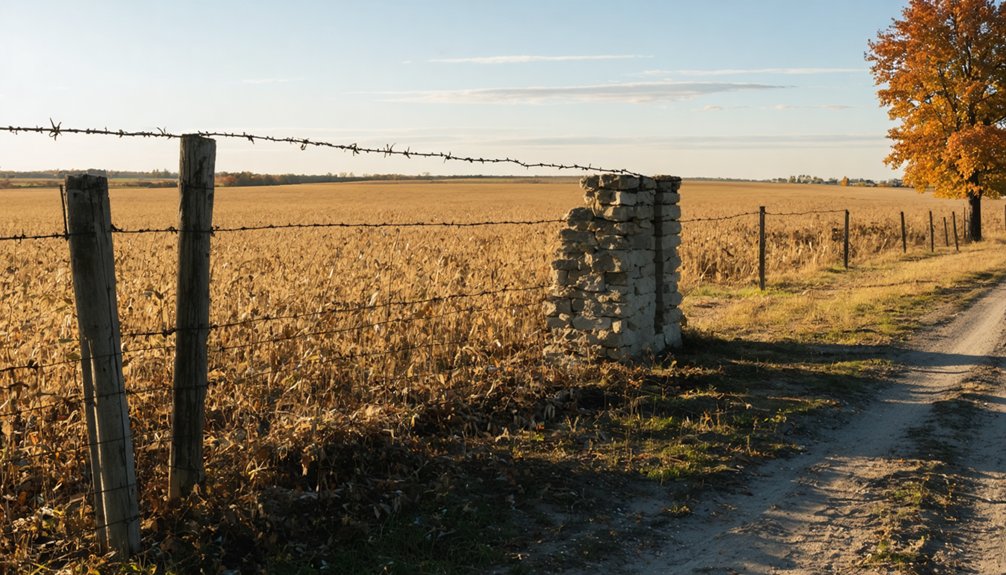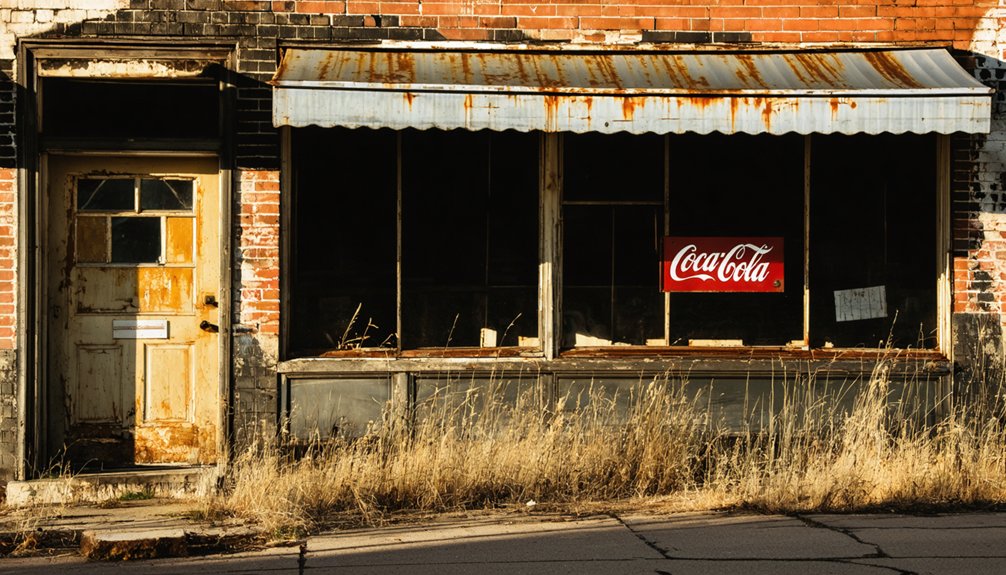You’ll find Clayville, Illinois tucked away in Sangamon County, where Moses Broadwell established an essential stagecoach stop in 1824. The historic Broadwell Inn, the county’s oldest brick building, once welcomed travelers and hosted notable guests like Abraham Lincoln. While the arrival of railroads in the 1850s transformed this bustling waypoint into a ghost town, the site’s preserved Federal-style architecture and compelling stories of frontier life still draw visitors today.
Key Takeaways
- Clayville was founded in 1824 as a stagecoach stop by Moses Broadwell, featuring the historic Broadwell Inn, Sangamon County’s oldest brick building.
- The town never grew beyond 100 residents and functioned primarily as a transportation hub along the Springfield-to-Beard’s Ferry post road.
- Clayville’s decline began in the 1850s when railroads replaced stagecoach transportation, causing the town to lose its economic significance.
- The nearby development of Pleasant Plains contributed to Clayville’s transformation into a ghost town as population and commerce shifted away.
- The abandoned town site now hosts community events and preservation efforts through the Pleasant Plains Historical Society, which acquired it in 2010.
The Rise of a Stagecoach Haven
When Moses Broadwell established Clayville in 1824, he created what would become an essential stagecoach stop between Springfield and Beardstown, Illinois. After receiving a federal land grant of 153½ acres from President James Monroe, he built the Broadwell Inn, which still stands as Sangamon County’s oldest brick building.
You’ll find that this strategic location along busy stagecoach routes transformed Clayville into a crucial hub for early commerce. The inn served as more than just a rest stop – it became a critical resupply point where you’d encounter stagecoach passengers, freight carriers, and cattle drovers from 1824 until 1847. The inn frequently hosted legal professionals and travelers while maintaining its reputation as a respected public house.
The Broadwell family designed their inn in the style of English country taverns, creating a welcoming haven that supported regional trade and travel before railroads dominated transportation. The establishment played a vital role in local agriculture as livestock transport made regular stops at the inn.
Life at the Historic Broadwell Tavern
You’d find the Broadwell Tavern bustling with activity during its heyday, as stagecoach passengers, cattle drovers, and legal circuit riders, including Abraham Lincoln, sought meals and lodging at this vital stop along the Springfield-to-Quincy post road.
The tavern’s daily operations, managed by John Broadwell after 1827, centered around providing essential services while functioning as a vibrant community hub where travelers and locals gathered for business and socializing. The structure’s enduring quality was ensured by using bricks made locally on the Broadwell farm.
Beyond the main tavern services, the entrepreneurial Broadwell family expanded their influence by operating complementary businesses like a tannery and wood mills, making the establishment a cornerstone of local commerce until railroad travel diminished its significance in the 1850s.
Daily Tavern Operations
During its heyday in the 1820s-1840s, the Broadwell Tavern operated as a bustling public house built from locally-made brick, serving travelers and locals alike with food, drink, and lodging.
You’d find the tavern menu featuring typical English country inn fare, while upstairs bedrooms provided rest for weary stagecoach passengers, including notable guests like Abraham Lincoln.
The tavern’s legacy made it one of the oldest brick structures in Illinois.
The establishment served as more than just a stopping point – it was a crucial community hub where you could attend political gatherings, especially Whig Party meetings that gave Clayville its name.
Under Moses Broadwell’s management until 1827, and later his son John’s leadership, the tavern employed local staff including cooks, servers, and stable hands.
Even after a major fire in 1834, the rebuilt tavern continued serving travelers until railroad expansion led to its decline.
Stagecoach Stop Culture
Life at the Broadwell Tavern centered around its essential role as a stagecoach stop along the post road connecting Springfield to Beard’s Ferry.
You’d have encountered a vibrant stagecoach culture where diverse travelers – from circuit-riding judges to cattle drovers – converged for rest and refreshment. The tavern’s Federal-style architecture, with its warming fireplaces and glass windows, provided frontier comfort for weary passengers. Merchants regularly transported dry goods and hardware through the stop.
Traveler interactions made the tavern a dynamic social hub. You might’ve exchanged news with fellow guests in the first-floor barroom or shared a meal with notable figures like Abraham Lincoln.
As an information exchange point, the tavern fostered community connections while delivering essential services mandated by Illinois law for stagecoach stops – including food, lodging, and care for both passengers and animals.
Broadwell Family Memories
The Broadwell family’s legacy at their historic tavern began in 1820 when Revolutionary War veteran Moses Broadwell established roots in Sangamon County.
You’ll find their ancestral roots traced back to New Jersey, where family stories of determination and enterprise began long before their Illinois settlement.
- You can still see remnants of their pioneering spirit in the brick structure they built from clay harvested right on their farm – one of Illinois’ earliest brick buildings.
- Their entrepreneurial drive led them to operate multiple ventures, from a tannery to wood mills alongside the tavern.
- They named their settlement “Clayville” after Henry Clay, showing their political engagement.
- After the devastating 1834 fire, they rebuilt stronger, leaving visible marks that tell their story of resilience in an upstairs bedroom.
From Bustling Stop to Quiet Ghost Town
Once a thriving stagecoach stop between Springfield and Beardstown, Clayville’s transformation into a ghost town began with the arrival of railroad technology in the 1850s.
You’ll find that this technological shift dramatically altered established stagecoach routes, triggering profound economic shifts that would forever change this Illinois hamlet.
The Broadwell Tavern, which had served as a crucial logistics hub since 1834, lost its prominence as travelers abandoned horse-drawn transportation.
The hamlet’s population never exceeded 100 residents throughout its existence.
Much like the iron foundries that once defined another Clayville in New York, this Illinois town’s industrial potential faded away.
The center of local settlement drifted to nearby Pleasant Plains, and one by one, Clayville’s wooden structures vanished into history.
Despite the eventual paving of the old stagecoach road into Illinois Route 125, nothing could restore the town’s former vitality.
Today, only the brick tavern stands as a silent witness to Clayville’s bustling past.
Preserving Illinois’ Oldest Brick Building
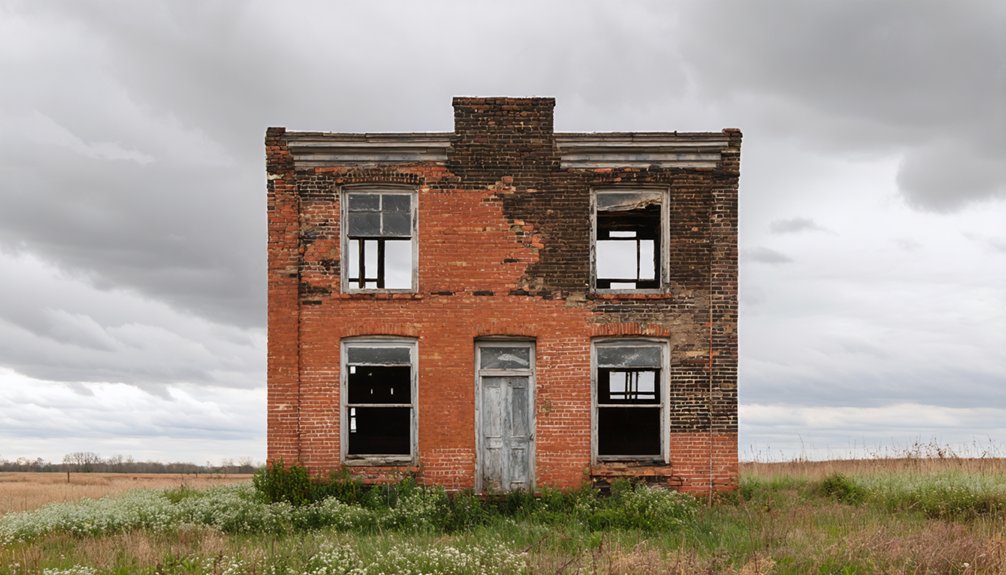
You’ll find the remarkable Broadwell Inn, Illinois’ oldest brick building, stands as a symbol of early 19th-century craftsmanship with its hand-hewn beams and rare brick beehive oven.
The Pleasant Plains Historical Society‘s 2010 acquisition saved this endangered landmark from potential demolition, allowing preservation of original materials like walnut mantels and hand-forged hinges. The historic structure once served as a bustling stagecoach stop between Springfield and Beardstown.
Today, this Federal-style structure serves as a living history museum, offering visitors tangible connections to frontier life through its authentic furnishings and architectural features from the 1820s.
Restoration Challenges and Solutions
Preserving Illinois’ oldest brick building presents a complex web of challenges that demand innovative solutions and careful consideration of historical integrity. The Broadwell Inn’s native handmade clay bricks and wooden elements require specialized restoration techniques that honor preservation ethics while protecting the structure’s Federal period character. The hand-forged hardware throughout the building requires meticulous maintenance to prevent rust and ensure operational longevity.
- You’ll find the original materials battling Illinois’ harsh weather extremes, from scorching summers to freezing winters, accelerating deterioration of the historic fabric.
- The building’s proximity to Richland Creek creates moisture issues that threaten the foundation’s stability.
- Modern environmental regulations restrict traditional restoration methods, requiring innovative alternatives.
- Balancing historical accuracy with structural needs demands non-invasive solutions, like internal bracing and careful integration of modern systems while maintaining authentic craftsmanship.
Historical Significance Today
As Illinois’ oldest brick structure, the Broadwell Inn stands today as a tribute to early 19th-century frontier life and Federal-style architecture.
The building’s historical preservation efforts have maintained authentic features like the brick beehive oven, hand-hewn beams, and original well, offering you a genuine glimpse into frontier living.
Today, you’ll find this cultural heritage site serving as an open-air museum where the past comes alive.
You can explore restored log cabins and a schoolhouse while experiencing interactive demonstrations and seasonal festivals.
The inn’s significance extends beyond its architectural uniqueness – it’s where stagecoach travelers, circuit lawyers like Abraham Lincoln, and cattle drovers once gathered.
Through guided tours and educational programs, you’re connecting directly with the social customs and daily life of Illinois’ early settlers.
Modern-Day Events in a Historic Setting
Despite its status as a ghost town, Clayville Historic Site maintains a vibrant calendar of events that breathe new life into its historic setting.
You’ll find festival activities throughout the year that connect you to the region’s rich heritage while fostering community engagement.
- Spring brings historical reenactments that transport you back to the site’s heyday, with authentically costumed interpreters sharing stories of Illinois’ frontier days.
- Summer welcomes folk music enthusiasts for traditional performances that echo through the restored tavern grounds.
- Fall festivals transform the site into a bustling marketplace with local crafts, regional foods, and family entertainment. Visitors can watch skilled artisans demonstrate traditional crafts like weaving and quilting throughout the festival grounds.
- October’s haunted house festival creates spine-tingling experiences within the atmospheric brick tavern, making creative use of the site’s ghost town reputation.
The Broadwell Family Legacy
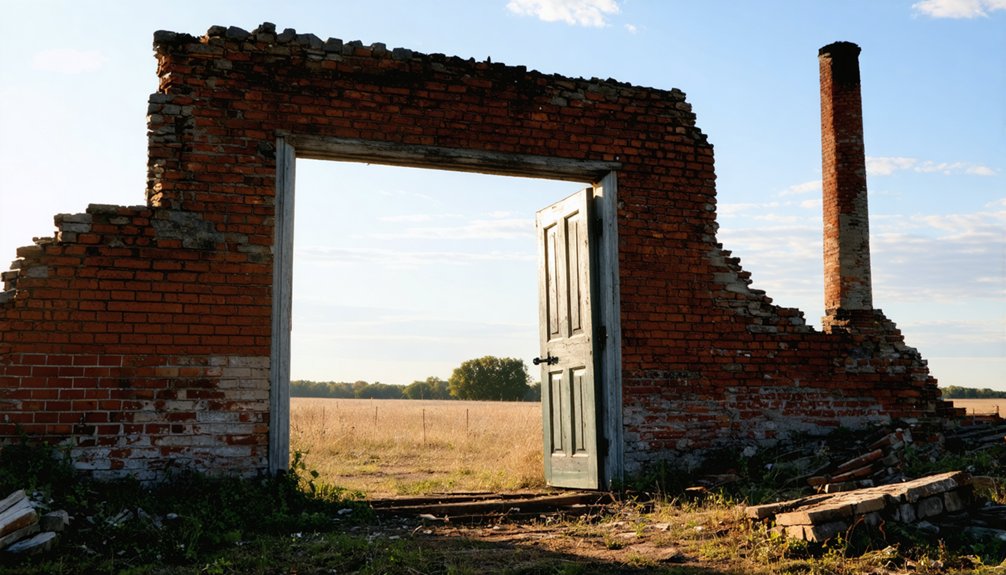
The Broadwell family’s pioneering spirit transformed the Illinois frontier through their entrepreneurial vision and determination. When Moses Broadwell led the family migration from New Jersey to Illinois in 1820, you’d find a raw frontier ready for development. His purchase of 3,000 acres laid the foundation for what would become Clayville’s thriving commercial center.
You can trace the Broadwell descendants’ impact through their ambitious ventures: the historic Broadwell Inn, a busy stagecoach stop that welcomed travelers like Abraham Lincoln; their brick kiln and tannery that powered local industry; and their bold attempt to establish Sangamo Town as the county seat.
While their dream of a dominant regional hub didn’t materialize, the Broadwells left an indelible mark on Sangamon County’s development, with the inn standing today as the county’s oldest brick structure.
Community Efforts to Save Clayville’s Heritage
When Pleasant Plains Historical Society formed in 2009, they initiated an ambitious $500,000 mission to rescue Clayville’s endangered historic site from destruction. Under Jim Verkuilen’s leadership, community involvement became the driving force behind this heritage preservation project.
- After years of neglect and funding cuts since 1992, volunteers cleared dense vegetation and performed essential structural repairs across the 13-acre property.
- The site, once listed among Illinois’ most endangered historic places in 2007, now hosts educational activities and historical reenactments.
- The Broadwell Tavern’s listing on the National Register of Historic Places reinforces its significance to Illinois’ cultural heritage.
- You’ll find the restored site stands as a symbol of community perseverance, where countless volunteer hours transformed a deteriorating landmark into an accessible historical treasure.
Frequently Asked Questions
Are There Any Reported Ghost Sightings at the Broadwell Tavern?
You won’t find documented ghostly encounters at the Broadwell Tavern, and while spectral legends often surround historic buildings of this age, there aren’t any confirmed paranormal reports from this location.
What Was the Average Cost of Staying at the Tavern in 1824?
Light your pocket like a lantern – you’d spend between 50 cents to $1.50 for historical accommodations at the tavern, which included your bed and meal during 1824’s frontier-era tavern pricing.
How Many Stagecoaches Typically Stopped at Clayville per Day During Peak Times?
You won’t find exact daily stagecoach numbers in historical records, but during peak travel periods in the 1830s-1840s, the tavern regularly served multiple stagecoaches as an essential rest stop.
Did Any Famous Outlaws or Bandits Ever Visit the Broadwell Tavern?
Like searching for a needle in a haystack, you won’t find any outlaw legends or bandit encounters at Broadwell Tavern. Historical records show only legitimate travelers like stagecoach passengers and politicians stopped there.
What Native American Tribes Originally Inhabited the Clayville Area?
You’ll find the Illiniwek Confederation tribes, including Cahokia, Kaskaskia, Peoria, and Tamaroa, originally inhabited this area. Later, the Kickapoo controlled the region until their forced removal in 1819.
References
- https://en.wikipedia.org/wiki/Clayville
- https://kids.kiddle.co/Clayville
- http://www.clayville.org/History
- https://drloihjournal.blogspot.com/2022/09/lost-towns-of-illinois-clayville.html
- https://www.sj-r.com/story/lifestyle/2012/05/04/clayville-history-resurrected/41740647007/
- https://visitspringfieldillinois.com/LocationDetails/?id=Clayville-Historic-Site
- https://sangamoncountyhistory.org/wp/clayville-historic-site/
- http://www.clayville.org
- https://postcardhistory.net/2020/08/carrolls-clayville-stagecoach-stop/
- https://www.sj-r.com/story/news/2016/09/19/clayville-festival-provides-entertaining-look/25423042007/
